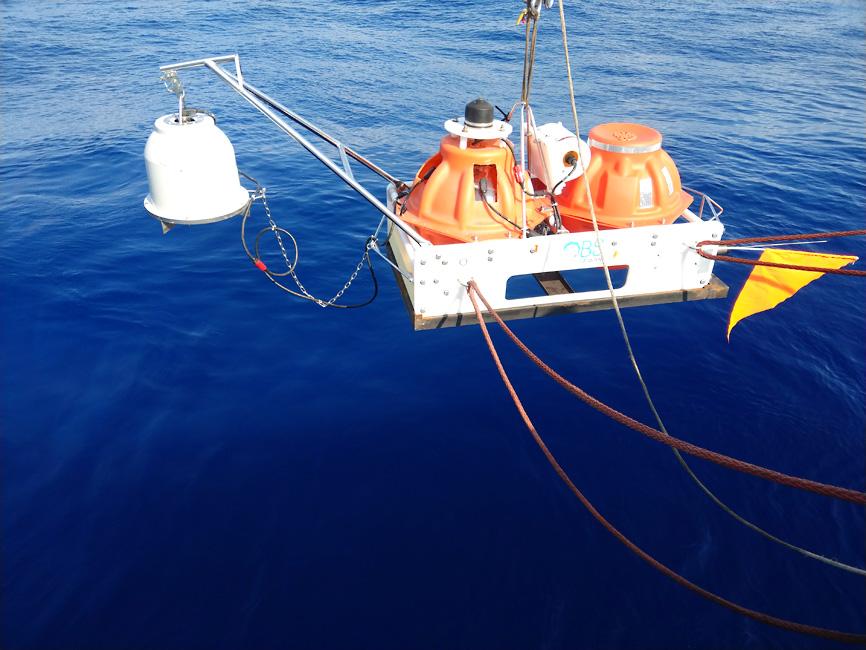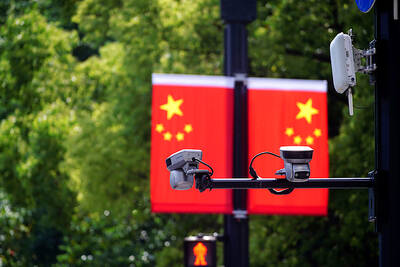Taiwan plans to join the US, Japan and South Korea to survey the Pacific tectonic plate with locally built ocean bottom seismometers (OBS) next year, which would allow scientists to chart new research areas, Academia Sinica Institute of Earth Sciences research fellow Kuo Ban-Yuan (郭本垣) said.
The opportunity arose after he led a team of Taiwanese researchers to deploy an OBS array in the Northern Okinawa Trough onboard the research vessel Legend (勵進) from 2018 to last year in collaboration with the Japan Agency for Marine-Earth Science and Technology and the University of the Ryukyus, Kuo told the Taipei Times on March 16.
Inaugurated in May 2018, the 2,629 tonne Legend is managed by the National Applied Research Laboratories’ Taiwan Ocean Research Institute (TORI).

Photo courtesy of Academia Sinica research fellow Kuo Ban-Yuan
It was the first time that Taiwanese and Japanese scientists had cooperated on research of this kind and scale within Japan’s exclusive economic zones, he said.
He thanked Taiwan-Japan Cultural and Economic Association honorary chairman Cheng Chi-Yao (鄭祺耀) and former Japanese representative to Taiwan Mikio Numata for their help, which made the voyages possible.
In September 2018, they deployed 35 OBSs in the trough and recovered 33 of them nine months later, Kuo said.
The survey found that earthquakes below the northern trough can happen at depths of up to 300km, deeper than a previous observation of nearly 200km, he said.
Once the team has published the first round of their findings, the OBS data would be made available on the Taiwan Earthquake Research Center or other platforms, he said.
Kuo said he is to lead a team to deploy an OBS array in the central Pacific Ocean in March next year, joining other academics from the US, Japan and South Korea to create the western wing of a Pacific array, which, when complete, would be made of more than 100 OBSs across the Pacific Plate — the world’s largest tectonic plate.
The Taiwanese team is to deploy 20 of the devices — 10 of them alongside ocean floor electro-magnetometers provided by the University of Tokyo — in an area where the crust is estimated to be 180 million years old — the oldest part of the Pacific Plate, Kuo said.
The seafloor between Guam and Hawaii is a “purer” area, with less volcanic activity and fewer crustal faults, allowing for observations of the fundamental workings of the lithosphere and asthenosphere, the top two layers of the Earth, he said.
The ocean is 5,000m deep there, he said.
Unlike satellites, which allow space-ground communications, marine geophysicists must recover the seismometers to get high-quality data, as frequent acoustic communication is too costly and not feasible, he said.
Despite the risks, more seafloor-based missions are needed, as land-based instruments have almost reached their limits, Kuo said.
The indigenous OBS development, which began in 2008, was led by National Sun Yat-sen University (NSYSU), TORI and Kuo’s lab, said TORI director-general Wang Chau-Chang (王兆璋), a former NSYSU Institute of Undersea Technology chairman.
The broadband seismometers can receive signals from nearly 20,000km away, Wang said.
They designed a leveling device to ensure that the seismic sensors sit stably regardless of unevenness on the seafloor and their high-energy-density lithium battery pack can last a year, he said.
In addition to the Taiwanese team, only certain laboratories in the US, the UK, Japan, Germany, France and China are capable of integrating an OBS’ hardware and software systems, he said.
Pusan National University in South Korea has purchased two from TORI, Wang said.
Developing more survey instruments instead of purchasing them from elsewhere is key to boosting research and industrial capacity, Kuo said.
As the nation is launching more research ships, domestic scientists have the opportunity to embark on bolder projects, he said, adding that hopefully the government would support more integrated Earth science projects.

CAUTION: Based on intelligence from the nation’s security agencies, MOFA has cautioned Taiwanese travelers about heightened safety risks in China-friendly countries The Ministry of Foreign Affairs (MOFA) yesterday urged Taiwanese to be aware of their safety when traveling abroad, especially in countries that are friendly to China. China in June last year issued 22 guidelines that allow its courts to try in absentia and sentence to death so-called “diehard” Taiwanese independence activists, even though Chinese courts have no jurisdiction in Taiwan. Late last month, a senior Chinese official gave closed-door instructions to state security units to implement the guidelines in countries friendly to China, a government memo and a senior Taiwan security official said, based on information gathered by Taiwan’s intelligence agency. The

The National Immigration Agency (NIA) said yesterday that it will revoke the dependent-based residence permit of a Chinese social media influencer who reportedly “openly advocated for [China’s] unification through military force” with Taiwan. The Chinese national, identified by her surname Liu (劉), will have her residence permit revoked in accordance with Article 14 of the “Measures for the permission of family- based residence, long-term residence and settlement of people from the Mainland Area in the Taiwan Area,” the NIA said in a news release. The agency explained it received reports that Liu made “unifying Taiwan through military force” statements on her online

Taiwan Semiconductor Manufacturing Co (TSMC), the world’s largest contract chipmaker, said yesterday that it is looking to hire 8,000 people this year, at a time when the tech giant is expanding production capacity to maintain its lead over competitors. To attract talent, TSMC would launch a large-scale recruitment campaign on campuses across Taiwan, where a newly recruited engineer with a master’s degree could expect to receive an average salary of NT$2.2 million (US$60,912), which is much higher than the 2023 national average of NT$709,000 for those in the same category, according to government statistics. TSMC, which accounted for more than 60 percent

Tung Tzu-hsien (童子賢), a Taiwanese businessman and deputy convener of the nation’s National Climate Change Committee, said yesterday that “electrical power is national power” and nuclear energy is “very important to Taiwan.” Tung made the remarks, suggesting that his views do not align with the country’s current official policy of phasing out nuclear energy, at a forum organized by the Taiwan People’s Party titled “Challenges and Prospects of Taiwan’s AI Industry and Energy Policy.” “Taiwan is currently pursuing industries with high added- value and is developing vigorously, and this all requires electricity,” said the chairman